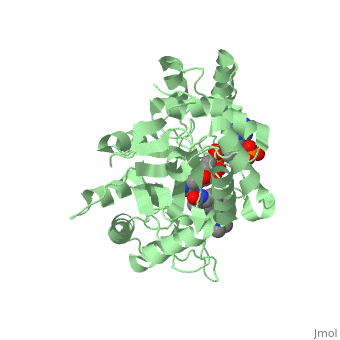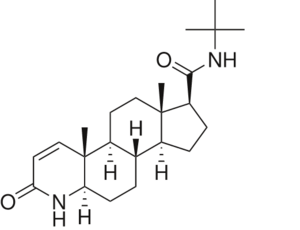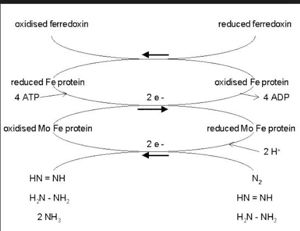Sandbox 45673
From Proteopedia
(Difference between revisions)
| (19 intermediate revisions not shown.) | |||
| Line 14: | Line 14: | ||
[[Image: Finasteride.PNG|thumb|300px|left|'''Fig. 1'''. Structure of Finasteride.]] | [[Image: Finasteride.PNG|thumb|300px|left|'''Fig. 1'''. Structure of Finasteride.]] | ||
| + | |||
| + | [[Image: Capture.JPG|thumb|300px|right|'''Fig. 1'''The interaction between 5β-reductase (green) and Finasteride (gray) and NADP (blue). Two Tyrosine (58 and 132 in yellow), two Tryptophan (89 and 230 in red) and Glutamic acid (120 in orange) residues in 5β-reductase are interacting with Finasteride. While Glutamine (193 in light blue) and aspartic acid (53 in purple) residues in 5β-reductase are interacting with NADP.]] | ||
{{Clear}} | {{Clear}} | ||
| - | |||
| - | [[Image: Capture.JPG]] | ||
| - | |||
| - | Fig. 2: The interaction between 5β-reductase (green) and Finasteride (gray) and NADP (blue). Two Tyrosine (58 and 132 in yellow), two Tryptophan (89 and 230 in red) and Glutamic acid (120 in orange) residues in 5β-reductase are interacting with Finasteride. While Glutamine (193 in light blue) and aspartic acid (53 in purple) residues in 5β-reductase are interacting with NADP. | ||
| - | |||
==Mechanism== | ==Mechanism== | ||
Finasteride is a 5α-reductase inhibitor. There are three isoforms of 5α-reductase, types I, II, and III. While the drug has a higher affinity for the type II enzyme, it also inhibits the function of the type I and no affinity for type III.<ref name="four"> Schieck, Cynthia L.(1998, August) "Finasteride (Propecia ®)". http://www.chm.bris.ac.uk/motm/finasteride/Finasteride%20(Propecia)%20-%20Feature%20Molecule.htm </ref>The enzyme 5α-reductase turns Finasteride into dihydrofinasteride through an enzyme bound, NADP-dihydrofinasteride adduct.. However, Finasteride , having a high affinity for 5α-reductase, covalently binds to the enzyme as a Michael acceptor, through a functionally irreversible reaction which essentially halts the chemical process before the NADP-Dihydrofinasteride complex can be reduced to Dihydrofinasteride because of a change in the carbanion position in respect to its placement on the similar enolate intermediate created in the reaction where testosterone is converted into DHT by 5α-reductase.(figure 3) However, the NADP-dihydrofinasteride complex does eventually break down with a half life of about 1 month at 37˚C., which is why patients must continue taking the drug.<ref name="five"> Bull, Herbert G.*Garcia-Calvo,Margarita Andersson,Stefan†, Baginsky, Walter F.,Chan,H. Karen,Ellsworth,‡ Dina E., Miller,§ Randall R., Stearns,Ralph A.,Bakshi,Raman K.,Rasmusson, Gary H.,Tolman,Richard L., Myers,Robert W.,Kozarich,John W.,Harris,Georgianna S. (1995, August 6) Mechanism-Based Inhibition of Human Steroid 5R-Reductase by Finasteride: Enzyme-Catalyzed Formation of NADP-Dihydrofinasteride, a Potent Bisubstrate Analog Inhibitor. http://pubs.acs.org/doi/pdf/10.1021/ja953069t</ref> | Finasteride is a 5α-reductase inhibitor. There are three isoforms of 5α-reductase, types I, II, and III. While the drug has a higher affinity for the type II enzyme, it also inhibits the function of the type I and no affinity for type III.<ref name="four"> Schieck, Cynthia L.(1998, August) "Finasteride (Propecia ®)". http://www.chm.bris.ac.uk/motm/finasteride/Finasteride%20(Propecia)%20-%20Feature%20Molecule.htm </ref>The enzyme 5α-reductase turns Finasteride into dihydrofinasteride through an enzyme bound, NADP-dihydrofinasteride adduct.. However, Finasteride , having a high affinity for 5α-reductase, covalently binds to the enzyme as a Michael acceptor, through a functionally irreversible reaction which essentially halts the chemical process before the NADP-Dihydrofinasteride complex can be reduced to Dihydrofinasteride because of a change in the carbanion position in respect to its placement on the similar enolate intermediate created in the reaction where testosterone is converted into DHT by 5α-reductase.(figure 3) However, the NADP-dihydrofinasteride complex does eventually break down with a half life of about 1 month at 37˚C., which is why patients must continue taking the drug.<ref name="five"> Bull, Herbert G.*Garcia-Calvo,Margarita Andersson,Stefan†, Baginsky, Walter F.,Chan,H. Karen,Ellsworth,‡ Dina E., Miller,§ Randall R., Stearns,Ralph A.,Bakshi,Raman K.,Rasmusson, Gary H.,Tolman,Richard L., Myers,Robert W.,Kozarich,John W.,Harris,Georgianna S. (1995, August 6) Mechanism-Based Inhibition of Human Steroid 5R-Reductase by Finasteride: Enzyme-Catalyzed Formation of NADP-Dihydrofinasteride, a Potent Bisubstrate Analog Inhibitor. http://pubs.acs.org/doi/pdf/10.1021/ja953069t</ref> | ||
| - | [[Image: Biochem group project.PNG|thumb|500px|right|'''Fig. 3'''. Proposed mechanism of inhibition by Bull et. al. Image shows how the inhibition of 5alpha-reductase is achieved as Finasteride is used as a substrate to create an enolate intermediate, similar to the one made during the reduction of testosterone. However, the complex created does not allow for the proton transfer needed to complete the reduction of NADP-Dihydrofinasteride to Finasteride, because of the change in the carbanion position. PADPR= phosphoadenosine diphosphoribose<ref name="five">Bull, Herbert G.*Garcia-Calvo,Margarita Andersson,Stefan†, Baginsky, Walter F.,Chan,H. Karen,Ellsworth,‡ Dina E., Miller,§ Randall R., Stearns,Ralph A.,Bakshi,Raman K.,Rasmusson, Gary H.,Tolman,Richard L., Myers,Robert W.,Kozarich,John W.,Harris,Georgianna S. (1995 | + | [[Image: Biochem group project.PNG|thumb|500px|right|'''Fig. 3'''. Proposed mechanism of inhibition by Bull et. al. Image shows how the inhibition of 5alpha-reductase is achieved as Finasteride is used as a substrate to create an enolate intermediate, similar to the one made during the reduction of testosterone. However, the complex created does not allow for the proton transfer needed to complete the reduction of NADP-Dihydrofinasteride to Finasteride, because of the change in the carbanion position. PADPR= phosphoadenosine diphosphoribose<ref name="five">Bull, Herbert G.*Garcia-Calvo,Margarita Andersson,Stefan†, Baginsky, Walter F.,Chan,H. Karen,Ellsworth,‡ Dina E., Miller,§ Randall R., Stearns,Ralph A.,Bakshi,Raman K.,Rasmusson, Gary H.,Tolman,Richard L., Myers,Robert W.,Kozarich,John W.,Harris,Georgianna S. (1995) Mechanism-based inhibition of human steroid 5R-reductase by finasteride: Enzyme-satalyzed formation of NADP-dihydrofinasteride, a potent bisubstrate analog inhibitor. </ref>]] |
; | ; | ||
| Line 30: | Line 27: | ||
'''Benign Prostatic Hyperplasia (BPH)''' | '''Benign Prostatic Hyperplasia (BPH)''' | ||
| - | [[Aromatase]] and 5α-reductase is responsible for converting androgen hormones into estrogen and dihydrotestosterone (DHT). This chemical process of androgen hormones leads to a decrease in testosterone, but raises levels of DHT and estrogen <ref name="eight">Tacklind, J., Fink, H.A., MacDonald, R., Rutks, I., Wilt, T.J. (2010). Finasteride for benign prostatic hyperplasia. Cochrane database of systematic reviews 2010, Issue 10. Art. No.: CD006015. DOI: 10.1002/14651858.CD006015.pub3. </ref>. Estrogen is a key role in cells proliferating in the prostate and DHT is an anabolic hormone much more potent (dissociated from the androgen receptor slowly) than testosterone that when combined, causes a synergy to induce BPH <ref name="nine">Dragan, I., Misso, M. (2012). Lycopene for the prevention and treatment of benign prostatic hyperplasia and prostate cancer: A systematic review. Maturitas, 72 (4), 269 </ref>. The enzyme 5α-reductase is responsible for the synthesis of DHT in the prostate from circulating testosterone. 5α-reductase is located in the stromal cells, which is the main site for the synthesis of DHT, but it can also diffuse into epithelial cells close | + | [[Aromatase]] and 5α-reductase is responsible for converting androgen hormones into estrogen and dihydrotestosterone (DHT). This chemical process of androgen hormones leads to a decrease in testosterone, but raises levels of DHT and estrogen <ref name="eight">Tacklind, J., Fink, H.A., MacDonald, R., Rutks, I., Wilt, T.J. (2010). Finasteride for benign prostatic hyperplasia. Cochrane database of systematic reviews 2010, Issue 10. Art. No.: CD006015. DOI: 10.1002/14651858.CD006015.pub3. </ref>. Estrogen is a key role in cells proliferating in the prostate and DHT is an anabolic hormone much more potent (dissociated from the androgen receptor slowly) than testosterone that when combined, causes a synergy to induce BPH <ref name="nine">Dragan, I., Misso, M. (2012). Lycopene for the prevention and treatment of benign prostatic hyperplasia and prostate cancer: A systematic review. Maturitas, 72 (4), 269 </ref>. The enzyme 5α-reductase is responsible for the synthesis of DHT in the prostate from circulating testosterone. 5α-reductase is located in the stromal cells, which is the main site for the synthesis of DHT, but it can also diffuse into epithelial cells close by <ref name= "ten"> Bartsch, G., Rittmaster, R.S., Klocker, H. (2000). Dihydrotestosterone and the concept of 5alpha-reductase inhibition in human benign prostatic hyperplasia. European Urology. 37 (4): 367–80. doi:10.1159/000020181 </ref>. In both stromal and epithelial cells, DHT binds to a nuclear androgen receptors and signals transcription for cell growth. Finasteride is used to inhibit the 5α-reductase enzyme, which blocks the conversion of testosterone and inhibits the production of DHT. Thus, reducing prostate volume and BPH symptoms, such as urinating complications. Using finasteride could increase the risk for erectile dysfunction, decrease libido, and ejaulation disorder due to 5α-reductase being inhibited <ref name=""> Robaire, B., Henderson, N.A. (2006). Actions of 5alpha-reductase inhibitors on the epididymis. Molecular and Cellular Endocrinology. 250 (1-2): 190–5. doi:10.1016/j.mce.2005.12.044 </ref>. |
'''Prostate Cancer''' | '''Prostate Cancer''' | ||
| - | Prostate cancer is an androgen dependant adenocarcinoma. The FDA has not approved | + | Prostate cancer is an androgen dependant adenocarcinoma. The FDA has not approved Finasteride as a treatment for prostate cancer. A warning label was added, 5α-reductase inhibitors concerned scientist of an increased risk of high-grade prostate cancer. While taking Finasteride, the treatment for BPH lowers prostate-specific antigen (PSA), which could mask that prostate cancer is present. <ref name=""> Wilt, T.J., MacDonald, R., Hagerty, K., Schellhammer, P., Kramer, B.S. (2008). Five-alpha-reductase Inhibitors for prostate cancer prevention. Cochrane Database Syst Rev (2): CD007091. doi:10.1002/14651858.CD007091. </ref>. PSA is normally found at high concentration in prostate cancer patients. |
'''Androgenetic Alopecia (AGA)''' | '''Androgenetic Alopecia (AGA)''' | ||
| - | Androgenetic alopecia (AGA) is an androgen-dependent | + | Androgenetic alopecia (AGA) is an androgen-dependent condition of progressively thinning of the scalp hair. AGA is also referred to as male-pattern hair loss or baldness (MPB) and female-pattern hair loss in women. It is characterized by progressive shortening of the growing phase in hair follicles, anagen phase, during successive hair growth cycles, leading to decreased numbers of hair in anagen at any given time, and aggressive follicular miniaturization with conversion of terminal to vellus-like follicles <ref name="ten"> Paus, R., Cotsarelis, G. (1999).The biology of hair follicles. N. Engl. J. Med., 34, 491–497. </ref> Finasteride can treat AGA in men who lack AGA due to congenital deficiency of type 2 5α-reductase, the presence of increased 5α-reductase activity or DHT levels in balding scalp <ref name="eleven"> Yamana, K., Labrie, F., Luu-The, V. (2010). Human type 3 5α-reductase is expressed in peripheral tissues at higher levels than types 1 and 2 and its activity is potently inhibited by finasteride and dutasteride. Hormone Molecular Biology and Clinical Investigation. 2 (3). doi:10.1515/hmbci.2010.035. </ref>. This condition is caused by a build up of DHT in tissues (scalp). The build up of DHT causes androgen-dependent scalp hair follicles to shrink. Testosterone converts dihydrotestosterone (DHT) by the enzyme 5α-reductase to be maximally active in scalp hair follicles. Inhibition of the 5α-reductase enzyme with Finasteride has been shown to reduce both serum and scalp skin DHT levels in balding men. <ref name="twelve"> Olsen, E. A., Hordinsky, M., & Whiting, D., et al. (2006, December). </ref> Side effects from Finasteride include but are not limited to, decreased sexual ability and desire. <ref name="thirteen"> Leyden, James et al.(June 1999)."Finasteride in the treatment of men with frontal male pattern hair loss." Journal of the American Academy of Dermatology. Volume 40 , Issue 6 , 930 - 937 </ref> |
Current revision
N-(1,1-dimethylethyl)-3-oxo-(5α,17β)-4-azaandrost-1-ene-17-carboxamide (Finasteride)
| |||||||||||
References
- ↑ 1.0 1.1 I.K. Morton; Judith M. Hall (6 December 2012). Concise Dictionary of Pharmacological Agents: Properties and Synonyms. Springer Science & Business Media. pp. 121, 246. ISBN 978-94-011-4439-1
- ↑ 2.0 2.1 Yamana K, Labrie F, Luu-The V (January 2010). Human type 3 5α-reductase is expressed in peripheral tissues at higher levels than types 1 and 2 and its activity is potently inhibited by finasteride and dutasteride. Hormone Molecular Biology and Clinical Investigation. 2 (3). doi:10.1515/hmbci.2010.035
- ↑ Varothai, S; Bergfeld, WF (Jul 2014). "Androgenetic alopecia: an evidence-based treatment update.". American journal of clinical dermatology. 15 (3): 217–30. doi:10.1007/s40257-014-0077-5. PMID 24848508
- ↑ 4.0 4.1 4.2 4.3 Lednicer D (2011). Steroid Chemistry at a Glance. Hoboken: Wiley. ISBN 978-0-470-66084-3
- ↑ 5.0 5.1 Burkhard Fugmann; Susanne Lang-Fugmann; Wolfgang Steglich (28 May 2014). RÖMPP Encyclopedia Natural Products, 1st Edition, 2000. Thieme. pp. 1918–. ISBN 978-3-13-179551-9
- ↑ Schieck, Cynthia L.(1998, August) "Finasteride (Propecia ®)". http://www.chm.bris.ac.uk/motm/finasteride/Finasteride%20(Propecia)%20-%20Feature%20Molecule.htm
- ↑ 7.0 7.1 Bull, Herbert G.*Garcia-Calvo,Margarita Andersson,Stefan†, Baginsky, Walter F.,Chan,H. Karen,Ellsworth,‡ Dina E., Miller,§ Randall R., Stearns,Ralph A.,Bakshi,Raman K.,Rasmusson, Gary H.,Tolman,Richard L., Myers,Robert W.,Kozarich,John W.,Harris,Georgianna S. (1995, August 6) Mechanism-Based Inhibition of Human Steroid 5R-Reductase by Finasteride: Enzyme-Catalyzed Formation of NADP-Dihydrofinasteride, a Potent Bisubstrate Analog Inhibitor. http://pubs.acs.org/doi/pdf/10.1021/ja953069t
- ↑ Tacklind, J., Fink, H.A., MacDonald, R., Rutks, I., Wilt, T.J. (2010). Finasteride for benign prostatic hyperplasia. Cochrane database of systematic reviews 2010, Issue 10. Art. No.: CD006015. DOI: 10.1002/14651858.CD006015.pub3.
- ↑ Dragan, I., Misso, M. (2012). Lycopene for the prevention and treatment of benign prostatic hyperplasia and prostate cancer: A systematic review. Maturitas, 72 (4), 269
- ↑ 10.0 10.1 Robaire, B., Henderson, N.A. (2006). Actions of 5alpha-reductase inhibitors on the epididymis. Molecular and Cellular Endocrinology. 250 (1-2): 190–5. doi:10.1016/j.mce.2005.12.044
- ↑ Olsen, E. A., Hordinsky, M., & Whiting, D., et al. (2006, December).
- ↑ Leyden, James et al.(June 1999)."Finasteride in the treatment of men with frontal male pattern hair loss." Journal of the American Academy of Dermatology. Volume 40 , Issue 6 , 930 - 937




